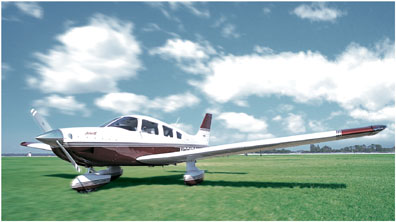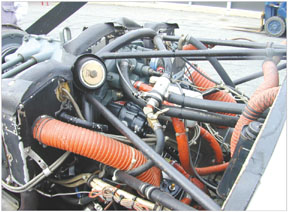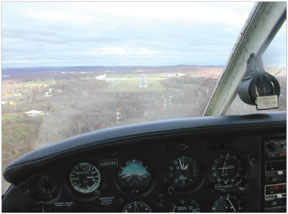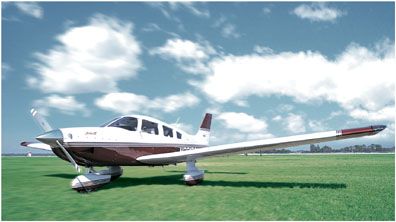
Back in the days when flight training was a growth business, would-be pilots had two choices when it came to training: Cessna and Piper. While Cessna dominated the market with its popular 150/152/172 series, Piper earned a definite niche with its Cherokee line, one of the most enduring designs in general aviation.
Whats the appeal? Buyers and pilots like the Cherokees low wing as an alternative to the Cessna high wing and the Piper line just had a more solid feel. The Lycoming O-360 proved to be a practical, durable powerplant we’ll suited to the Archers weight and performance needs. Among the most popular Cherokees was the PA-28-180 line which eventually morphed into what we now know as the Archer.
Thanks to this broad-based appeal, a good recent model Archer still commands a healthy price on the used market and, depending on model year, will draw about a $10,000 premium over an equivalent model Cessna 172.
Although its not necessarily the perfect airplane, for many owners, the PA-28-180 series comes close. Its a good entry-level airplane suitable for training but its fast enough to fly modest cross-country trips. Payload is such that it really will carry four people without suffering a heavy hit against the fuel load.
Further, the Cherokee 180/Archer swims among some quirky competition, such as the Cessna Cardinal, Grumman/AGAC Tiger and the Beech Sundowner in the used market. Now that Cessna is back with the 172 and 182 and the Tiger has also come back on the market, the field is more crowded than ever.
Nonetheless, the Archer is still out there, with a new one sporting an Avidyne Entegra glass panel, fancy paint and a gussied up low-drag cowl. It has a price to match: we’ll above $300,000, if equipped with generous options.As recently as 2003, the Archer III remained New Pipers best-selling airplane, but it has since been eclipsed by the revised PA-32 series, including the 6X. And, of course, the Cirrus SR20 entry-level cruiser outsells the Archer by four or five to one.
Model History
The PA-28-180 line is a shining example of what Piper has always done best: Build a good basic model and then evolve it over the years into follow-on products that are improved but arent increasingly difficult or expensive to build. The 180 series sprang from the basic Cherokee 140 and such aircraft as the Arrow, Saratoga and even the Seminole twin owe their existence to the first Cherokee airframe originally designed by the late John Thorp. Thorp is best known for the crank-winged Thorp T-18 homebuilt, among many other designs. He considered the PA-28 among his favorites and if you view the wings in plan form, you can easily see the resemblance between the first Cherokee and the Thorp T-18.
Within this spectrum, the Archer occupies the center lane of the mission requirement. First rolled out in 1963, it has been upgraded considerably but it is fundamentally still the same airframe, with some 10,000 flying. The original Cherokee 180 had the constant-chord Hershey-bar wing (span 30 feet) and a Lycoming O-360-A3A engine with a TBO of only 1200 hours, due to a valve-train design that was far from Lycomings best effort. Those problem engines had 7/16-inch exhaust valves, which were later switched to -inch valves.Besides the shorter TBO, the smaller valves had issues with excessive wear and heat-induced damage. By now, the smaller valves should have been flushed entirely from the market by overhaul or remanufacture. But check anyway at pre-buy, if youre looking at an older 180. The newer engines all carry Lycomings more-or-less standard 2000-hour TBO.
The airframe remained largely unchanged until 1968 when the panel was modernized and the extra trapezoidal rear window was added. This gives the airplane its current modern look and the cabin gets more light, thanks to the extra glass. A longer wing came along in 1973-still the constant chord, though, not the tapered wing-a bigger stabilator was added and the fuselage was stretched 5 inches, offering noticeably more room in the cabin. A boost in gross weight of 50 pounds (to 2450 pounds) improved the airplanes payload by nearly half a person and a bigger door, more crashworthy seats and yet more panel improvements rounded out the cosmetic improvements.
Throughout its model history, the PA-28-180 has used essentially the same Lycoming O-360-still 180 HP-with only minor variant changes. For a brief time, the Cherokee became the Challenger but that wasnt a native American name so Piper chose Archer to match the Arrow. Neither of those are native American names either but despite the illogic, Pipers naming conventions are easier to follow than Mooneys name-change conventions.
The new tapered wing-standard yet today-was introduced in 1976, although it appeared on the Warrior two years earlier. The rest of the Piper singles shed the old Hershey bar wing at about this time, in favor of the tapered design. The inner panels were still constant-chord, while the outer panels were tapered. This change was so significant the designation changed, too, from PA-28-180 to PA-28-181, along with yet another name: Archer II.
The Archer II got some powerplant changes as well, to include the A4M version of the 180-HP Lycoming O-360, an engine that has earned its stripes in the TBO hall of fame. The Bendix mags, which some owners swore at, were replaced by Slicks, which some owners also swore at. Our owners surveys and sweeps of service difficulty reports reveal that Bendix mags arent significantly more or less reliable than Slicks, although the Slicks are cheaper.
These changes brought escalating prices-in 1980, a typically equipped Archer II sold for $47,610. (Of minor interest, if airplane prices had simply tracked inflation, that same airplane would cost $118,000 in 2005 dollars.)In 1995, Piper introduced the Archer III, which carries through to the present product line. The current New Piper Archer III has gone through numerous minor changes, including the upgraded cowl, an all-metal instrument panel, Garmin GNS430/540 navigators, new paint schemes, air conditioning, improved seats and the aforementioned glass panel.
Market Scan
Any would-be owner looking to upgrade from a basic trainer or even looking for an affordable entry-level airplane will always at least consider an Archer. Its attributes are too compelling to do otherwise. Its a bit faster than a Cessna 172, climbs better and carries a smidge more than the Skyhawk, all without gulping fuel the way a 182 does. Maintenance costs are on the low side of reasonable.
Early Archers-say the 1974 to 1975 models-sell in the high $50,000 range, as of fall 2005. Archer IIs up into early 1990 model years fetch about $110,000 to $115,000. By comparison, a 1986 Cessna 172 retails for about $80,000 while an American General Tiger of the same vintage will sell for about $61,000, give or take.
Used Archers vary widely in installed equipment. A recent scan of Trade-A-Plane revealed quite a few with motley panels in which one old Bendix/King KX-170B was replaced with a newer digital KX-155 or, occasionally, a Garmin GNS430. Some have mid-1980s upgrades with Bendix/King Silver Crown stacks.Clearly, some Archers have gone through extensive upgrade cycles but if owners lavish big bucks on these airframes, they probably tend to keep them and not flip them into the used market.
Load, Comfort, Performance
For a 180-HP airplane, Archers haul respectable loads. Empty weights vary by year and example, of course, but one owner told us his PA-28-180s empty weight was 1452 pounds on a gross weight of 2400 pounds. With full tanks, that allows 650 pounds of people and stuff, or three husky people and a bit of baggage. Not bad.
Later Archers allow a 2550-pound gross but empty weights are often higher, so payloads are lower. A new Archer III, says New Piper, weighs in at a hefty 1680 pounds empty, for a useful load of 870 pounds. Older Archers beat that by 75 pounds or more. With four people in the airplane and, say, 50 pounds of baggage, a typical Archer has room for 35 to 40 gallons of gas, or about three hours endurance with 45-minute reserves. Again, not bad for a modest airplane. If the passengers are light, full fuel and full seats may be possible.
Occupants should have no trouble remaining comfortable during a three-hour leg, although pre-1973 backseats are somewhat tight. Pipers have decent but not exceptional front seats with an S-shaped frame that absorbs energy in a crash. The height adjustment has a gas spring and when this wears out, the seat plops to the lowest setting, giving a short pilot a good view of the glareshield but little else. The seat stuffing tends to hog out with use, causing sagging and the plastic back trays on the seats arent at all durable and fall apart with use.
There’s an adequate baggage compartment behind the rear seats thats accessible in flight. Also, although the baggage door can be opened from the inside, the back windows cant. Check the baggage door for a leaking seal; the tell-tale sign is wet or waterstained carpet on the baggage floor.Performance-wise, the Archer is respectable, but no one would mistake it for a Bonanza or even an Arrow. How fast you go on 180 HP depends on the year of manufacture and the equipment. Specifically, the semi-tapered wing on the 1976 and later Archers yielded benefits at both ends of the airspeed spectrum. The stall dropped by 4 knots and cruise speed went up by about the same amount. The large wheel pants that became available in 1978 add another 4 knots or so to the Archers cruise speed. Even so, a late-model Archer with wheel pants will go only about 120 knots, although some owners insist they see 125 to 130 knots. (We suspect erroneous airspeed indicators.) The airplane gives up 10 knots to a Tiger but pulls ahead of a Cessna 172.
Climb rate, while better than a 172, isn’t stellar. According to the POH, the airplane will climb about 750 FPM at low altitudes but that diminishes we’ll below that above 5000 feet or so. The performance of the airplane depends to a certain extent on the year. Pre-1973 models with the shorter wings wont climb as we’ll as later models. Owners report that the 1973 to 1975 models with longer Hershey bar wings are nearly as good as the later taper-wing Archer IIs.
The Archer didnt get to be everymans airplane by having handling quirks; it simply has none. Its safe, stable and predictable and quite easy to land, even on short runways. In slow flight, it has no bad habits nor does it build speed rapidly in unusual attitudes. One trick to improving control smoothness is to keep the yoke shaft we’ll lubed. Watch the short-wing Hershey bar models on final, however. Theyll sink at slow speeds with the power back to idle.

Maintenance, Systems
The Archers systems are about as simple as these things get. The fuel selector is on the side wall by the pilots left knee, where its not readily visible but still easily reachable. It has left/right/off but no both position, as in Cessnas. The trim system varies by year. Early models had an overhead crank system which the pilot would inevitably turn the wrong way.Later models have the more intuitive trim wheel.
Common to all Cherokees-right through the big sixes-are manual flaps, which we consider a superior design for their simplicity and quick, positive operation. There’s little doubt about how far the flaps are extended and apart from occasional lubrication and bushing work, the manual flap system is maintenance-free. Really, all small airplanes should have manual flaps.
Panel layout varies with year, with the older ones being somewhat scattershot, testament to the early days before the standard T-configuration arrived. Newer models are we’ll thought out, with two exceptions: The engine gauges, tach and fuel gauges are low on the panel, out of the line of sight.In our view, this is a terrible design oversight.
Generally speaking, Archers don’t have much AD baggage. The Archer was the target of a controversial AD in 1987 calling for an expensive inspection of the wing spar for cracks. This procedure required de-mating the wings and cost some $1200. In typical FAA overreaction, it was an emergency measure brought about by the crash of a 7000-hour Archer used for pipeline patrol.Fortunately, that AD was rescinded when the expected rash of cracked spars failed to materialize.
However, in reviewing recent service difficulty reports, we noted that mechanics are finding evidence of corrosion in the spars, at least once of which required replacement of the spar. This corrosion is often discovered when leaking fuel tanks are removed for repair. Make sure a pre-buy includes inspection of spars. Check the wing attach fittings, too. Corrosion has been found on these.
In a misguided effort to save weight, Piper at one time equipped its airplanes with aluminum battery cables, which proved susceptible to corrosion and had current transmission problems, resulting in sluggish cranking.There’s a Piper service bulletin noting that the aluminum cables should be replaced with copper and many owners have done so. Check any airframe youre considering for this mod because the service difficulty reports still turn up airplanes in which it hasnt been done.
Another problem is leaky fuel tanks, particularly on older airplanes. An AD addresses peeling tank sealant so its not much of a problem any more, certainly nothing like the hassle of owning a Mooney. But, it should still be checked on any older Cherokee 180. The vents are also a source of maintenance trouble. One SDR found that they had been installed incorrectly.
Otherwise, maintenance hotspots have to do with typical Lycoming issues, such as cracked cylinders, corroded cams and problems with Bendix and Slick magnetos. Also, on older airframes, the stabilator bushings may need work.Have them checked during pre-buy. Another area worth looking at, according to the SDR database, is cracking in the skins of the forward wing walk area. One SDR submitter reported six high-time airframes with this damage.
Mods, Owner Groups
Various aerodynamic mods are available from LoPresti Speed Merchants 800-859-4757 or www.flyfast-lopresti.com and Met-Co-Aire at 800-814-2697 or www.metcoaire.com. LoPresti has flap gap seals, a cowling and flap hinge fairings. Met-Co-Aire has replacement wingtips and dorsal fins. You can order STOL kits from Horton, Inc. (800-835-2051) and Sierra Industries (888-835-9377 or www.sijet.com) still supports but doesnt actively market STOL mods for the Cherokee.
Knots 2 U (www.knots2u.com or 262-763-5100) sells various Cherokee mods including gap seals, wingtips and gear fairings. For tuned exhaust systems for the PA-28 line, check out PowerFlow Systems at 877-693-7356 or www.powerflowsystems.com. Laminar Flow Systems sells gap seals, wheel fairings and other clean-up kits for the Cherokee. See www.laminarflowsystems.com or call 888-327-8140. For fiberglass exterior parts, of which the Cherokee has many, try Globe Fiberglass at www.globefiberglass.com or 800-899-2707.
There are two owners groups for the Cherokee. The Cherokee Pilots Association (813-948-3616 and www.piperowner.com) is devoted entirely to the Cherokee line while the Piper Owner Society (www.piperowner.com) offers support for the entire Piper line. Both organizations have magazines and online support mechanisms.
Owner Feedback
I have owned a 1978 Piper Archer II for 14 years. While I have been part owner in much more sophisticated pressurized singles and twins, when it came to a purchase of my own plane, I chose the Archer.
The Archer II is an airplane that wont betray you. It is a simple airplane, with low maintenance, low insurance and no demands from insurers for special training in order to be insured. I am a flying salesman and land the Archer II in grass fields, as we’ll as large airports. It is a good instrument airplane and with a Garmin GNS530, weather and traffic displays, there arent too many surprises in the instrument flying world. Its good with short fields and grass fields and can carry three adults and baggage with full fuel.
In 2005, my insurance was $1400 for $90,000 hull value and $1 million liability. Typical annuals are about $2000, but I am usually improving something as well. The new Archers are not very different from my 25-year-old Archer II, so there is good support for parts. But the insurance is low, because the hull value is low.
The first engine flew for 2600 hours and I replaced it with a Mattituck rebuild with Millennium cylinders. I have 350 hours on the new engine, with no problems at all. Everybody can repair an Archer. The Lycoming engine is reliable and there are no surprise maintenance or repair problems. It starts easily, even when hot, and runs well.
I flight plan for 120 knots and burn about 9.5 GPH. The tanks hold 48 gallons useable. I added gap seals and have the large wheel fairings. I plan for three-hour legs on instrument flights. This makes longer trips less exhausting and assures plenty of fuel for alternate airports. The cabin is large enough and the seats are comfortable. But, on long trips against a headwind, it would be great to have a faster airplane. This is the only drawback to the Archer.
As aviation gas prices continue to climb and some FBOs at larger airports want excessive mark-ups, the Archers low fuel consumption is the best defense and does not limit my use of the airplane. I fly a lot in the New York metro area and the East Coast. The ability to fly over the congestion, even at only 120 knots, is a real blessing!
The Archer is an everymans airplane that provides excellent value and good reliability. Its not as exciting as some of the more exotic aircraft available, but in my view, lack of excitement and low costs are a good thing in aviation.
Christopher Anderson
Morristown, New Jersey
I obtained my private license at age 53. My wife is now working toward her private license and Im currently working on an instrument rating. After I was offered all sorts of great deals on Mooneys, Bonanzas and so on, I asked our flight instructor, a man in his 70s, with umpteen hours, to recommend an airplane.
He came up with the Archer, which we bought for $53,500. It was a 1979 Archer II, with dual VOR, glideslope, DME, ADF and Mode-C transponder. As a beginner to flying (only 300 hours), I find the Archer II a very docile aircraft to fly. It behaves itself quite we’ll and you really have to work to get into trouble with it.
With regard to costs, it seems to be cheap as I compare it to other owners at the airport and it ranks we’ll against the Cessna 172. Fuel burn is 8.5 GPH at 65 percent, running to 9.5 to 10.5 GPH at 75 percent. Weve replaced two magnetos, a brake line, spark plugs, two tires and some avionics work. All in all, for the age of the aircraft and the amount we use it (32 hours a month, for my wife and me), I feel these expenses are in the ballpark.
All in all, this airplane is a joy to fly and own. As we look to the future, we have plans to purchase a new aircraft and we seriously believe it will be a New Piper Archer III. The price is right and its good record of safety and reliability sells itself.
Wayne A. Sarno
Via e-mail
I purchased a 1977 Archer II for the flying club I was a member of a few years back. At the time, it had about 3000 hours on the airframe and had been we’ll maintained. Typical of the year, it had a pair of older KX-170B navcoms, an ADF and an old Narco DME, with a Piper AutoControl wing-leveler autopilot. All of this equipment proved to be durable and easy to maintain, although the autopilot was finicky and eventually left to go to seed.
Given insurance costs and the relatively poor record of flying clubs, the Archer is the ideal airplane for either a group or a club. It has just enough power to provide modest performance but not so much to get a pilot into trouble. Further, the Archers handling traits are absolutely docile and predictable. It will manage a crosswind without requiring exceptional skill and even if the pilot botches the approach and landing, the aircraft is forgiving enough to handle the insult with aplomb. Of course, flying clubs are known for having…well, idiots among their members and so did ours. A runway overrun wiped out the nosegear, prop and lower cowling. One of the great puzzlements is how you run an Archer off a 3500-foot runway, but thats club flying at its best.

The Archer is not the fastest. For cross country and instructional purposes, we filed for 118 knots or so and that yielded fuel burns between 9 and 10 GPH. With full tanks, the Archer is best thought of as a four-hour airplane, tops. That leaves a generous reserve for VFR, less so for IFR. Its a good IFR airplane, with rock solid stability and no tendency to build speed rapidly or fall off on one wing when its left alone.
The airplane is an excellent short field performer for pilots willing to hone their technique. With full flaps and trimmed carefully, it will fly an approach at 55 knots over the fence, at light weights. With vigorous braking, it will stop in a couple of hundred feet. Its less impressive on takeoff, requiring more runway to get out than to get in.
Piper seems to have all the parts you could ever need for the airplane and there are enough wrecks out there to provide used parts, if something major is needed. Any mechanic half worth his salt can fix this airplane, often with off-the-shelf parts. In club service, we had trouble with brake pads-the pilots tend to ride them-and the nosegear seemed to constantly need some kind of service to keep it from shimmying. The Lycoming O-360, on the other hand, seemed bulletproof and we had three engines make it past TBO with only minor midstream work.
A typical fix-everything annual costs between $2000 and $3000, but an annual with not much wrong could be done for $1200. For all their faults, clubs do give an accurate sense of true operating costs and for our club, the Archer ran about $45 per hour, figuring $2.50 gas, $8 for the engine reserve and $10 for general maintenance, plus a modest hourly charge for upgrades.The airplane rented for $48 an hour, wet. It would be higher with $3.50 gas, but thats still a pretty good deal for anything that can fly over 100 knots.
Name withheld
Also With This Article
“Piper PA-28-180/181 Archer Charts and Specs”
“Archer Accidents: No Smoking Guns”


